How to Peru in 2 weeks – Day #11: Titicaca Lake – Floating ‘Uros’ Islands – Taquile Island
According to an Inca legend, Manco Capac -the creator of Inca Empire- and Mama Occllo emerged from the waters of Titicaca Lake carrying a golden staff instructed by the sun god Inti to create a temple in the spot where the staff sank into the earth. Another legend says that Wiracocha itself emerged from the Titicaca waters, heading to Sacred Valley to establish Inca Empire. While the legends can continue, Uros people are real. It is not certain where they came from (maybe from the Amazon), but they moved on the waters of Titicaca since they were oppressed by the local population, and not able to get some land of their own. Originally, they built these islands near the middle of the lake, but due a major storm in 1986, they rebuilt them closer to the shore.

Booked with All Ways Travel a full day trip to both Uros and Taquile Islands, we started excitedly an early day. Picked up from the lobby of our hotel in Puno few minutes after 6:30 am, soon we found ourselves in the speed boat that will take us on the famous lake.
First stop: Isla Suma Wiljta, one of the approx 90 Floating Islands of Uros. About 5 km from the bay, we were there in no time. Uru, or Uro was the name of one of the first ethnic groups populating the Andean region, co-existing with the Incas, Aymara and maybe other older civilizations. These simple people lived for years on their boats used as floating houses, away from advanced civilization, using the reeds as main source to build boats, houses, to cook, to make fire, or to eat. When the Spanish conquistadores came over, Uros people were still living on their boats. Only in the early 60s, the Uros started to build small artificial islands with reeds, for their homes.

The indigenous people are still living on these floating islands. They use Totora reeds to make reed boats, and most importantly, to make their own islands. Most of the islands are small, about 30 metres wide, and house about 3-4 families. The biggest ones are for more families, or serve to a communal purpose, such as school, church, or restaurant.

The islands last about 25-30 years. Every 25 years or so, the inhabitants of each island start building a new one. The base is made of large pallets of Totora roots, tied together with ropes and anchored to the bottom by long poles. Due to their intertwined nature, they look like a huge block of roots, which offer stability and floatability to the island itself.

These blocks are covered constantly with multiple layers of reeds, every week for the first 6 months, afterwards only twice a month, but also depending on the weather, and the load of the island itself. Living in this century, Uros people started to use more modern materials, not only for their islands, and boats, but also for their personal use, such as radios, cell phones, TVs, solar panels.

Titicaca lake is mostly famous for the location: at its elevation of 3812 m above the sea, the lake is known the highest navigable lake in the world. But by volume of water and by surface area, it is the largest freshwater lake from South America.

While the main occupation for Uros people was fishing, these days they focus more on tourism. Not much fish is left in the lake, as the Trout was brought in the 40’s from Canada and kingfish from Argentina in the 50’s, so they started to do handicrafts and sell them to the tourists.
The small island we visited was big enough for six families, and after a short presentation how the island is built, each family took few of us into their own home. A small reed hut, with a double bed, a small dresser with a TV and a radio on top.
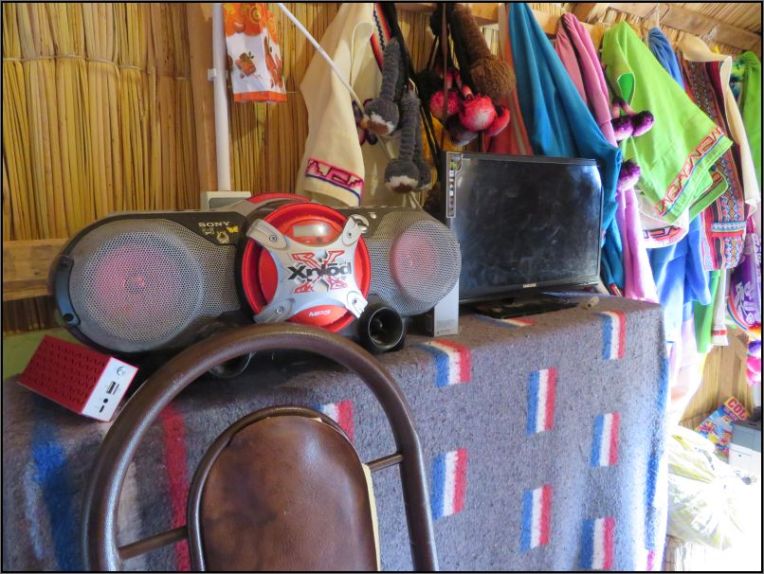
Husband and wife answered all our questions, mostly the man, who was speaking a pretty good English. They explained they have 2 children 12 and 14 years old, who were away to school at that time of the morning. We’ve learned they have 2 floating kindergartens and 1 elementary school, teachers coming on Mondays and leaving Fridays. Older children go to study in Puno instead.
I kindly asked if I’m allowed to take some photos, and they agreed smiling. For some reason I felt embarrassed for their poor conditions and could not take many photos inside.
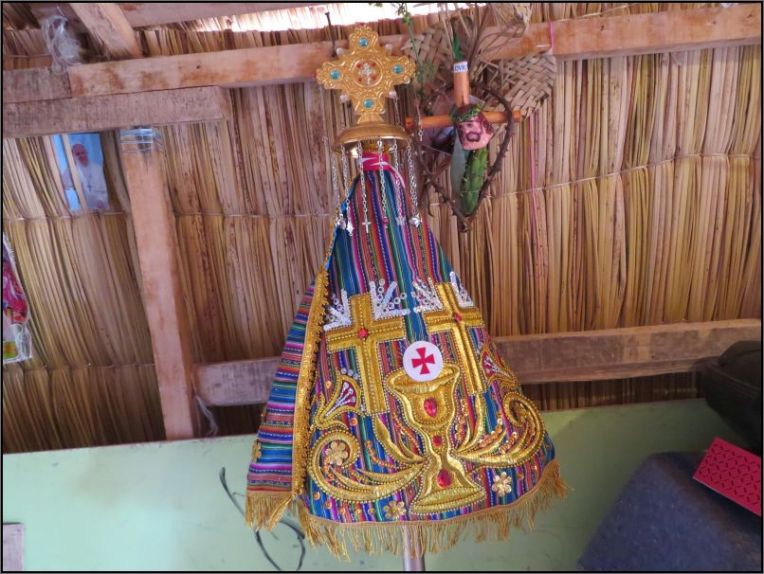
Their huge smiles encouraged me to ask them more questions, but soon we were outside, led to a small pile of handicrafts they were trying to sell us. I knew this will happen, as most of the online reviews mention that tourists are very upset of the situation, as the locals do really push you to buy stuff from them. Fair or not, I think this is the price all tourists must pay for being invited into these kind people houses, the price for letting us take pictures of themselves, of their own clothes, furniture, of their own privacy. But I didn’t know the value of this price, as some of them are pretty high, 4-5 time more expensive then stuff you can buy from the mainland. We ended up buying a pillow case manually sewn with indigenous motifs, and some small ceramics.

Interesting fact that all men from the island take turns each year in a leading position, with an equal chance in this way to have decisional actions for their own community. Sometimes, if some families are not getting along with the others, they will split the island and move away, or link it to another island/community.

After departing from Uros islands, we enjoyed an amazing view from the top of our boat, until it picked up some speed and we had to come down, inside. The ride can be bumpy, as the lake is large and can build big waves. We didn’t experience them, however, I am not a fan of small waves either. This way I learned that huge waves – up to 2 metres high – can build up on Titicaca Lake.
We’ve had about one hour to relax and socialize with other tourists while we arrived at Taquile Island. Two of their chiefs came to greet us while we were walking uphill. After exchanging some coca leaves with our guide, we were explained the habits and the laws of this small island.

Taquile is a hilly island located 45 km away from Puno. In 1970, it became property of Taquile people, and it is a little island full of traditions and tourists.
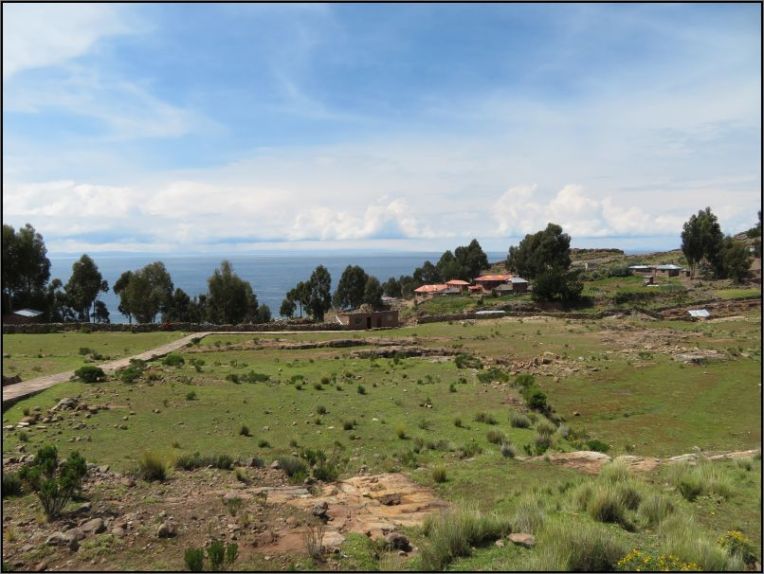
The people in Taquile run their society based on community collectivism and on the Inca moral code: ama sua, ama llulla, ama qhilla, (do not steal, do not lie, do not be lazy). The island is divided into six sectors. Each sector has its own leaders, and there is one more who leads all of them. They are openly, freely selected by everyone living on the island. The economy is based on fishing, terraced farming, but I think the tourism is their main income source (40,000 tourists per year as per Wikipedia).
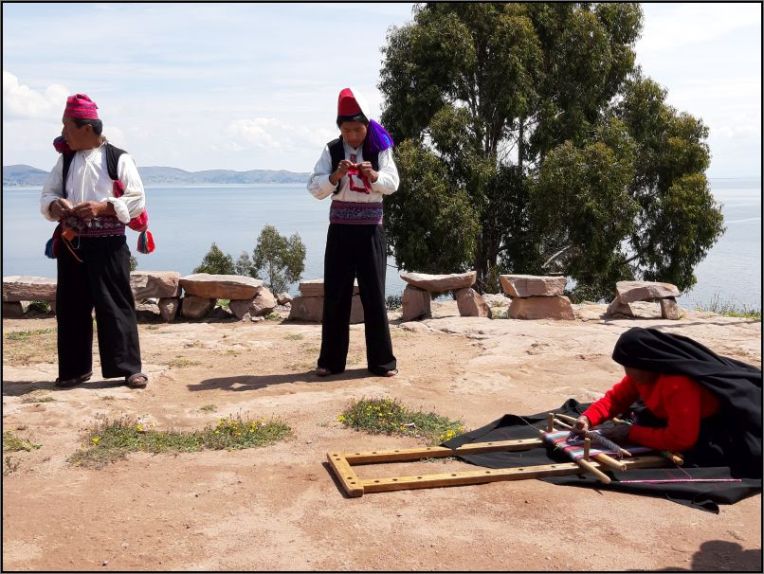
Taquile is especially known for its handicrafts. “Taquile and Its Textile Art” has been honored by being proclaimed “Masterpieces of the Oral and Intangible Heritage of Humanity” by UNESCO. The women exclusively make yarn and weave.

Knitting is exclusively performed by males, starting at age of eight. Their masterpiece is the marriage hat, which they start doing it when the marriage age is approaching. The young ones do knit a hat from alpaca wool, which supposed to hold 2 litres of water. The knitting for this hat is extremely tight, and once that is finished, they need to wear it for few weeks while they are not washing their hair. They didn’t mention why, but I guess the natural grease of their own hair will simply plaster any alpaca pore remained opened. The potential bride will do the test to pour the water, and if the hat will not hold the water for certain time, she can refuse the boy.

Taquileans are also known for having created an innovative, community-controlled tourism model, offering home stays, transportation, and restaurants to tourists. They are very proud of their own children who pursue careers at Puno University, in order to come back with business ideas for their small community.

Some people from our group took a hike to the top of the hilly island, while the rest of us took it at a slower pace to the area we had arrangements for lunch. The guide had quite few stops along the way to explain us a bit of history and answer questions.
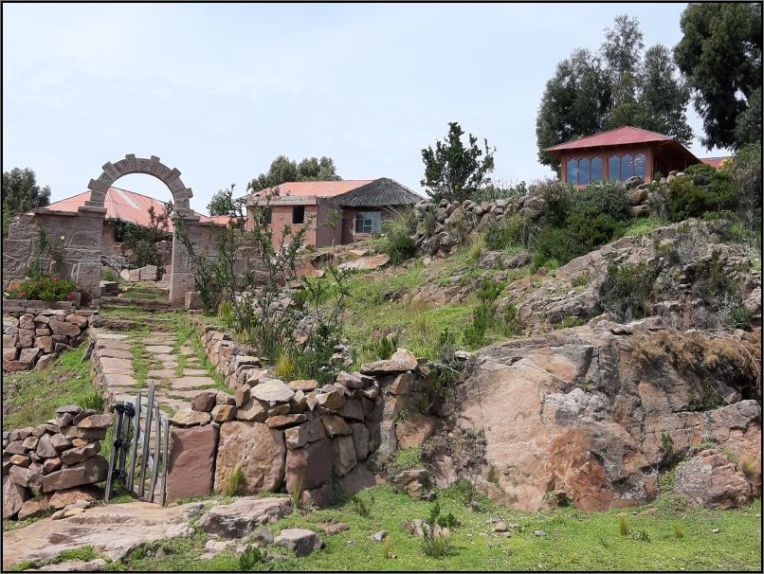
The big surprise we’ve had was before lunch, where a little show was put for us, more explanations about knitting, and some native music and dance.


The most impressive fact from the island is that they have a strict birth control. They realized a long time ago that the island resources are very limited, and they cannot have too many children. The marriages are strictly controlled/approved, and the young ones can marry people from outside the islands, but not all are allowed to come and live on the island. They can also live together up to two years before deciding if they should marry or not.
A serene place, the top of the island is a wonderful sport to admire the clear sky and the surrounding waters. One can not only forget about the busy life of a city, but can certainly find his/her own tranquility in the deep surrounding peaceful blue.

Tip(s) of the day:
- Dress properly before leaving on the lake. The weather can change rapidly, and can vary quite a lot. Dress warmly and in layers; take water, sunscreen and a hat with you;
- You can buy some goodies from Puno for the Uros people. They will insist you buy some (expensive) crafts from them, keep in mind you need to pay a price for them letting you come in their house. Or you can simply deny saying you don’t have cash with you. They will accept some donations, clothes included;
- Taquileans offer home stays for those interested;
- The uphill hike on Taquile can be exhausting, but there is no rush, you can make it;
- Whole trip costs $50.00 per person (we booked it online to save the spots), full day trip with a speed boat and lunch included. We were picked up from our hotel in Puno, and given a ride back when returning.
~ visited in April 2019

I enjoyed the overviews of both Titicaca Lake and Taquile Island, Christie. A wonderful combination of history and present, interesting facts, and fantastic photos.
LikeLiked by 1 person
Thank you so much Jet! An amazing part of our beautiful world lives there, we enjoyed very much our trip in Peru.
LikeLiked by 1 person
Great post! We visited Lake Titicaca including Taquile 12 years ago. I’m not sure if it’s a good thing or not, but it doesn’t look like it’s changed at all.
LikeLiked by 1 person
Thank you!! Lake Titicaca/Peru was on our list for a long time, and so happy we could finally get there! It is amazing how fast or slow different parts of this world evolves, isn’t it?
LikeLiked by 1 person
Full of info!
LikeLiked by 1 person
Full of information. Thanks, Christie. I can see where birth control would be important. The part about the hat holding water was amusing. Those knitting skills must be critically important. –Curt
LikeLiked by 1 person
We learned a lot during our whole trip, and I’m sure I have missed some of the info that our guide shared with us LOL It was a lot for us to process! Thank you for stopping by Curt
LikeLike
I suspect that you remember the most important, and certainly the most interesting parts!
LikeLiked by 1 person
Love this! I’m looking for a Peru tour which doesn’t include Machu Picchu and Cusco (been there, done that!) as I didn’t like the altitude. Are Titicaca and the rest of Peru any different?
LikeLiked by 1 person
Thank you! Each part of Peru has it’s own charm, but everything Southeast of Cusco is actually high altitude. Acclimatization is very important, and if I would go again, I will do the acclimatization in Aguas Caliente, as it is at a lower altitude than any other city around. Titicaca lake is actually at a higher altitude, and also Colca Canyon, which we did on a 2 day trip, following Titicaca.
I believe lower altitudes are in the Central and North of the country, but we only visited Lima: https://1000placesandmemories.wordpress.com/2019/08/03/pe-how-to-peru-in-2-weeks-day1-lima-miraflores-district/
LikeLike
I’ve just seen a documentary, in which actor Tony Robinson travelled by train from Arequita to Titicaca, and wonder if this is the way to acclimatise slowly.
However, the train, the ‘Belmond Andean Explorer’ belongs in the if you have to ask how much, you can’t afford it’ category. But maybe there are other, less expensive trains?
LikeLiked by 1 person
The documentary you’re talking about sounds interesting, I’ll check it out. A less expensive way of travelling is by bus. The bus from Lima to Cusco takes almost a full day, I would say enough time to acclimatize properly. Part of the route is along the coast, hence a beautiful view. I understand there are decent buses, something to take in consideration.
LikeLike
It’s a series called ‘Around the World by Train’ on our Channel 5; the episode covering South America is Ep. 2.
LikeLiked by 1 person
What a fascinating side trip and way of life to behold. I’m not sure I’ve ever read about people making these types of artificial islands before!
LikeLiked by 1 person
Thank you Lexie! We had an amazing trip on the lake, there was so much to learn about their everyday life (even though tourism is mostly their occupation these days🙂) I was fascinated how much load these reed islands can actually hold!
LikeLiked by 1 person
A great post, so interesting. It’s a place I probably won’t visit but it’s good to be able to read about it.
LikeLiked by 1 person
Thank you for your kind note Alison, glad you enjoyed to read🙂 But never say never, who knows? 😉
LikeLike